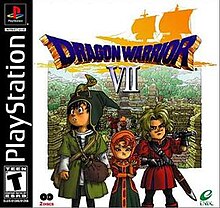
Back مسعى التنين 7 Arabic دراجون واريور ڤى ARZ Dragon Quest VII: Fragmentos de un mundo olvidado Spanish دراگون کوئست ۷ Persian Dragon Quest VII : La Quête des vestiges du monde French Dragon Quest VII: Frammenti di un mondo dimenticato Italian ドラゴンクエストVII エデンの戦士たち Japanese 드래곤 퀘스트 VII: 에덴의 전사들 Korean Dragon Warrior VII LLD Dragon Quest VII Dutch
| Dragon Quest VII: Fragments of the Forgotten Past | |
|---|---|
 Box art of the original North American PlayStation release, titled Dragon Warrior VII | |
| Developer(s) | Heartbeat ArtePiazza (3DS, iOS, Android) |
| Publisher(s) |
|
| Director(s) | Manabu Yamana |
| Producer(s) | Taichi Inuzuka |
| Designer(s) | Yuji Horii |
| Programmer(s) | Manabu Yamana |
| Artist(s) | Akira Toriyama Shintaro Majima |
| Writer(s) | Yuji Horii Sachiko Sugimura Fuminori Ishikawa Kazunori Orio |
| Composer(s) | Koichi Sugiyama |
| Series | Dragon Quest |
| Platform(s) | PlayStation, Nintendo 3DS, Android, iOS |
| Release | PlayStationNintendo 3DSiOS, Android |
| Genre(s) | Role-playing |
| Mode(s) | Single-player |
Dragon Quest VII: Fragments of the Forgotten Past[a] is a 2000 Japanese role-playing video game developed by Heartbeat[5] and ArtePiazza,[6] and published by Enix for the PlayStation. The game was produced by Yuji Horii,[5] who has presided over the Dragon Quest series since its inception. Artwork and character designs were once again provided by Dragon Ball creator Akira Toriyama,[5] the artist responsible for all previous Dragon Quest games. It was released in North America in 2001 under the title Dragon Warrior VII. The game received a remake on the Nintendo 3DS in Japan in 2013, released in English under the title Dragon Quest VII: Fragments of the Forgotten Past in 2016. A version of the game for Android and iOS was released in Japan in 2015.[7][8]
The game follows the Hero and his friends as they discover secrets about the mysterious islands surrounding their home of Estard. Through some ancient ruins, they are transported to the pasts of various islands and must defeat evil in each new location. Game mechanics are largely unchanged from previous games in the series, although an extensive Class system allows players to customize their characters.
Dragon Quest VII: Fragments of the Forgotten Past is the seventh installment of the popular Dragon Quest series of role playing games, and is the successor to 1995's Dragon Quest VI for the Super Famicom. An immediate success upon release, Dragon Warrior VII's sales totalled 4.06 million by April 6, 2001, making it the best-selling PlayStation game in Japan,[9] and is an Ultimate Hits title. It was the first main series Dragon Quest title to be released outside Japan since the release of Dragon Quest IV in North America in 1992, the last Dragon Quest title to be released in North America with the Dragon Warrior name, and the last Dragon Quest game outside of Japan to be published by Enix, before merging with Squaresoft in 2003 to form Square Enix.
- ^ "Dragon Warrior VII release date set". GameSpot. Retrieved 2023-11-19.
- ^ Sato (November 12, 2015). "Dragon Quest VII Headed Westward In Summer 2016 And Dragon Quest VIII In 2016". Siliconera. Retrieved May 19, 2020.
- ^ "Rebuild a shattered world". Nintendo of Europe GmbH.
- ^ "SQUARE ENIX announces DRAGON QUEST titles including DRAGON QUEST VIII for smartphones (For Japan)" (in Japanese). Square Enix. 2013-10-08. Retrieved 2013-10-08.
- ^ a b c Cite error: The named reference
ign_previewwas invoked but never defined (see the help page). - ^ Cite error: The named reference
ArtePiazzawas invoked but never defined (see the help page). - ^ "ドラゴンクエストVII エデンの戦士たち". App Store. 16 July 2020.
- ^ "ドラゴンクエストVII エデンの戦士たち - Apps on Google Play".
- ^ Cite error: The named reference
platinumwas invoked but never defined (see the help page).
Cite error: There are <ref group=lower-alpha> tags or {{efn}} templates on this page, but the references will not show without a {{reflist|group=lower-alpha}} template or {{notelist}} template (see the help page).